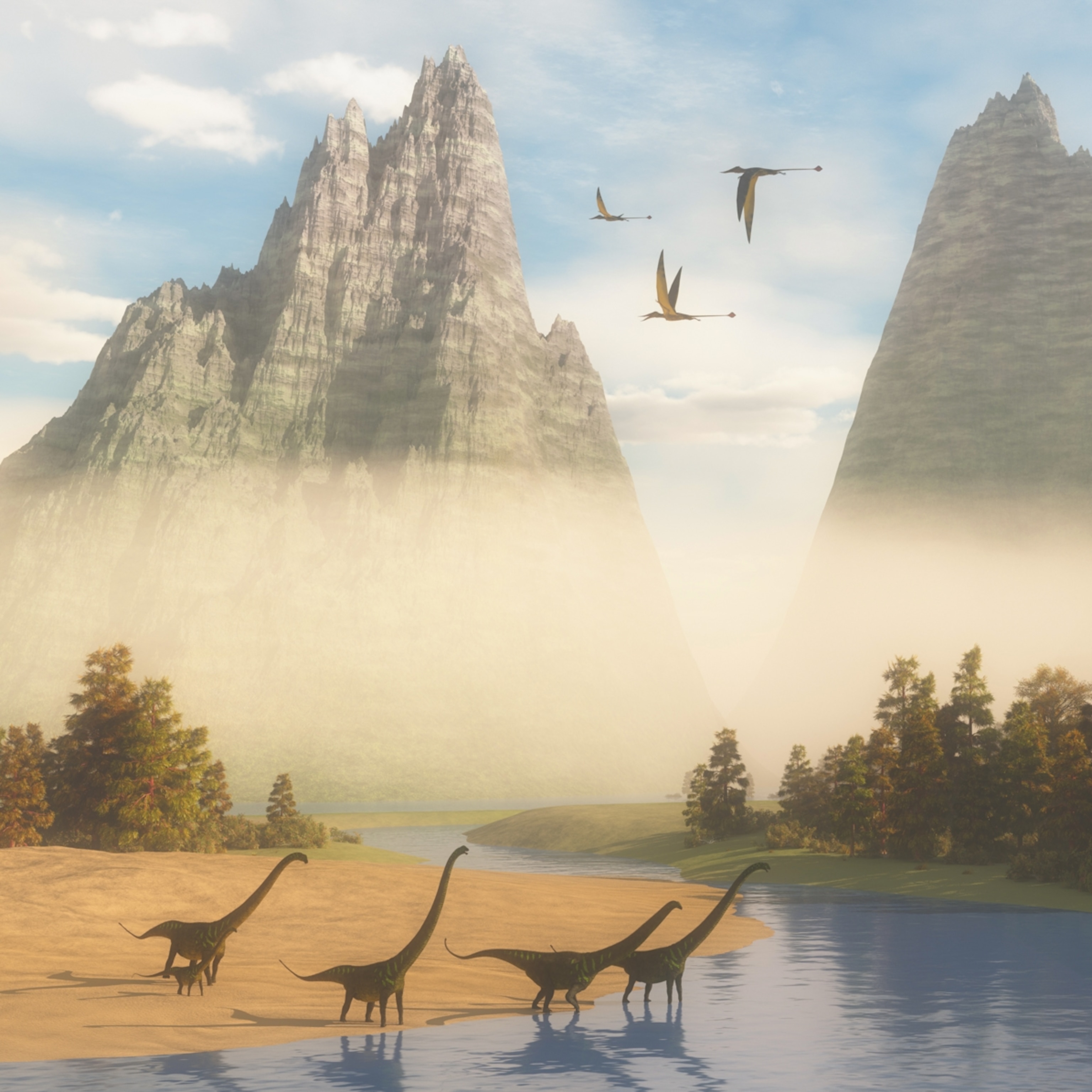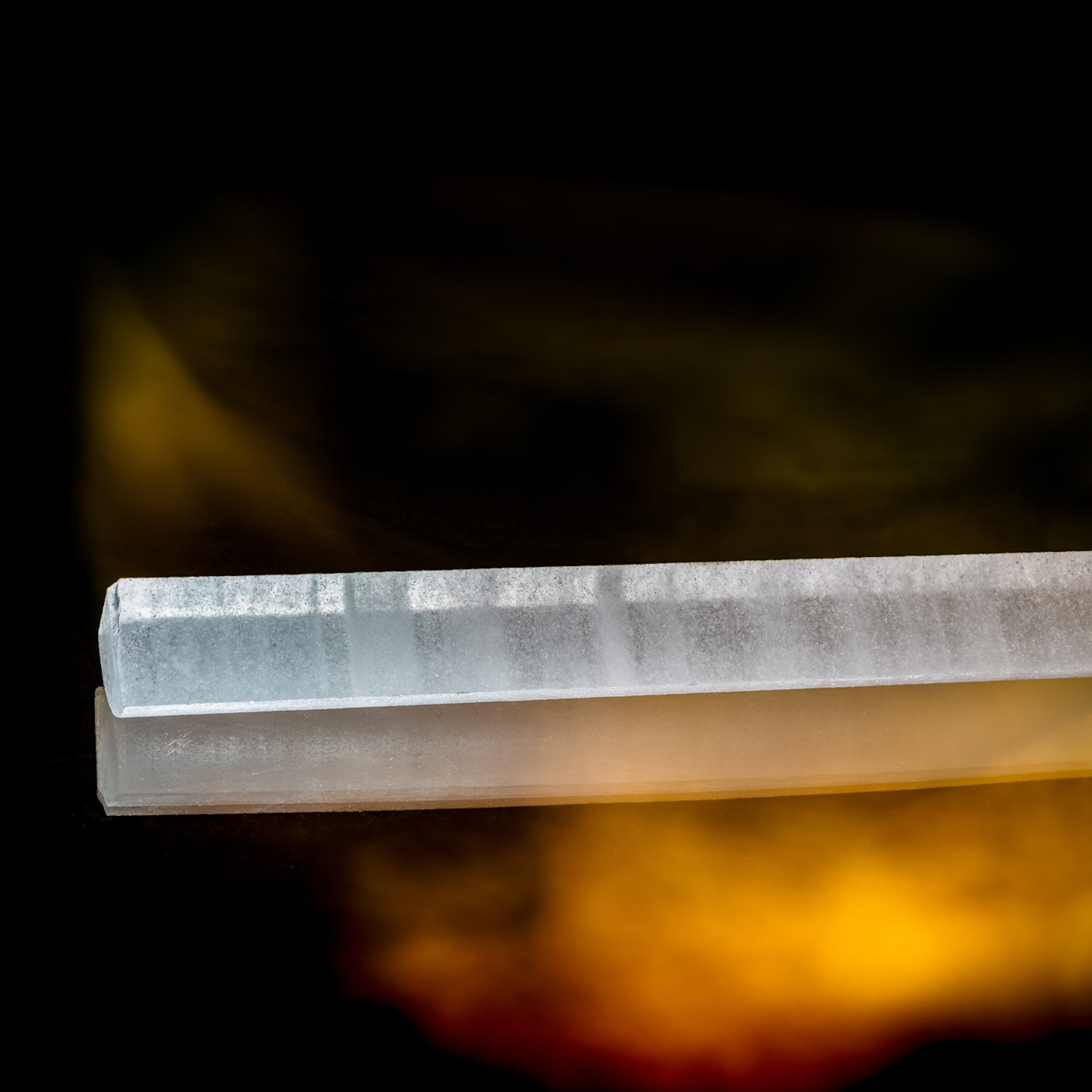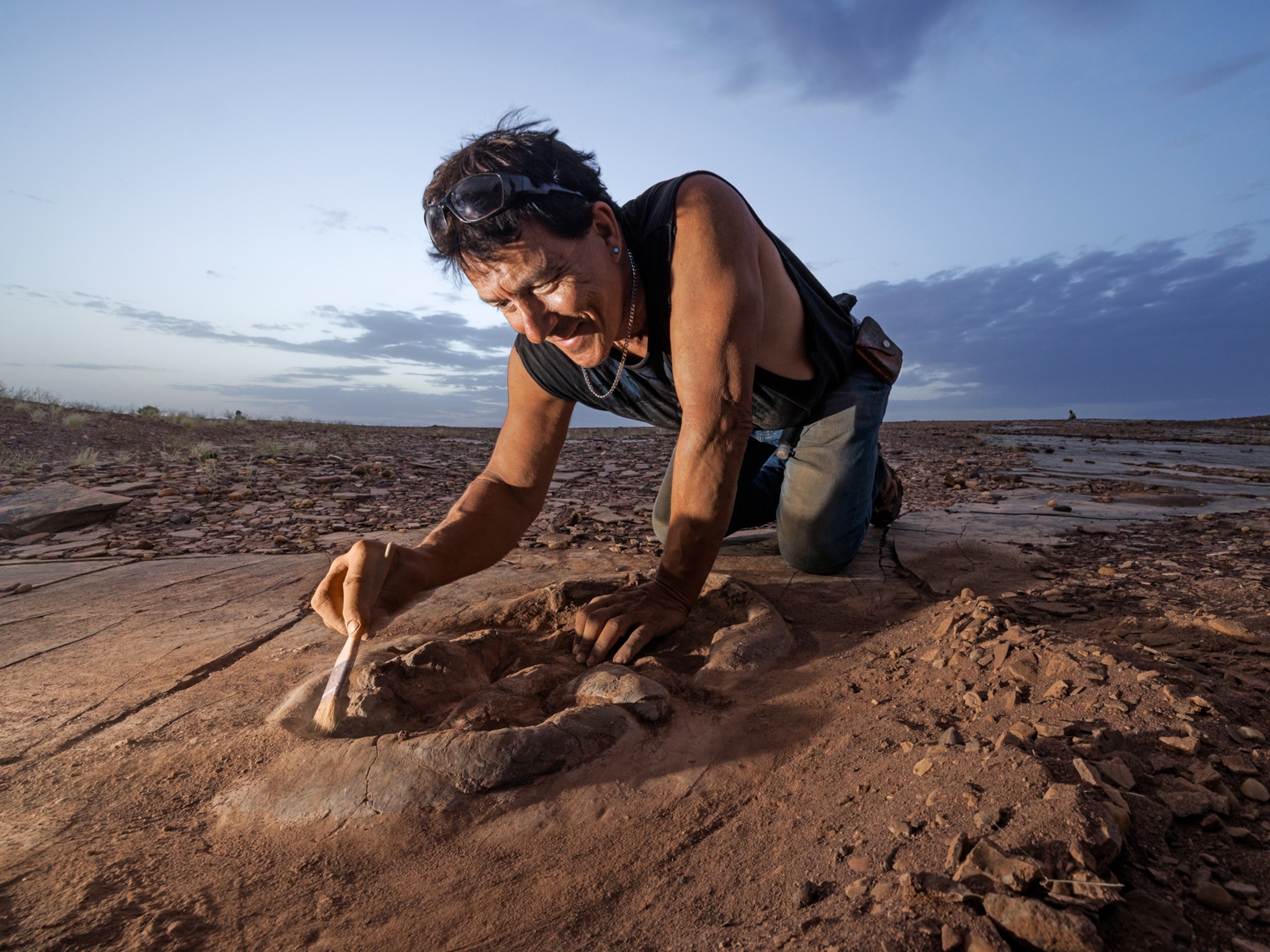"Welcome to the Black Triangle," said paleobiologist Cindy Looy as our van slowed to a stop in the gentle hills of the northern Czech Republic, a few miles from the German and Polish borders. The Black Triangle gets its name from the coal burned by nearby power plants. Decades of acid rain generated by power-plant emissions have devastated the region's ecosystems. Yet the treeless hills looked healthy and green.
I tried to hide my surprise. For months I'd been on the trail of the greatest natural disaster in Earth's history. About 250 million years ago, at the end of the Permian period, something killed some 90 percent of the planet's species. Less than 5 percent of the animal species in the seas survived. On land less than a third of the large animal species made it. Nearly all the trees died. Looy had told me that the Black Triangle was the best place today to see what the world would have looked like after the Permian extinction. This didn't look like apocalypse.
We saw the first signs of death as we walked into the hills—hundreds of fallen timbers lay hidden in the undergrowth. A forest once grew here. Half a mile (0.8 kilometers) uphill we found the trunks of a stand of spruce, killed by acid rain. No birds called, no insects hummed. The only sound was the wind through the acid-tolerant weeds.
"The forest that grew here a few decades ago contained dozens of species of plants," said Looy. "Now there are only a few grassy species."
Looy picked up a spruce cone. Pollen from the trees around us might be preserved inside. She believes that the Permian extinction was caused by acid rain following a massive release of volcanic gases. She wants to compare tree pollen from a modern forest killed by acid rain with fossil pollen found in Permian rocks.
Like a homicide detective at a crime scene, Looy sealed the cone in a plastic bag for later lab work. "You could say we're working on the greatest murder mystery of all time," she said.
Looy is one of many scientists trying to identify the killer responsible for the largest of the many mass extinctions that have struck the planet. The most famous die-off ended the reign of the dinosaurs 65 million years ago between the Cretaceous and Tertiary periods. Most researchers consider that case closed. Rocks of that age contain traces of an asteroid that struck Earth, generating catastrophic events from global wildfires to climate change. But the Permian detectives are faced with a host of suspects and not enough evidence to convict any of them.
To understand this extinction, I wanted first to get a sense of its scale. That's difficult—sediments containing fossils from the end of the Permian are rare and often inaccessible. One site that preserves the extinction's victims lies about a half day's drive inland from Cape Town, South Africa, in a scrubland known as the Karoo.
"The Karoo is the kind of place where people fall asleep at the wheel," said Roger Smith, a paleontologist at the South African Museum, as we drove across the treeless land. "But it may be the best place to see the terrestrial realm's transition from the Permian to the Triassic period."
We ascended through sheep-ranching country toward the Lootsberg Pass. The rocks that surrounded us date from the late Permian. For every yard of altitude we gained, we traveled tens of thousands of years forward in time, heading for the Permian's conclusion.
If we had driven here before the extinction, we would have seen animals as abundant and diverse as those of today's Serengeti, except most would have belonged to a group known as synapsids. Often called mammal-like reptiles—they looked like a cross between a dog and a lizard—the synapsids were Earth's first great dynasty of land vertebrates.
"We've found fossils of many kinds of synapsids in these rocks, especially tortoise-beaked dicynodonts, which likely lived in herds and browsed on vegetation along the riverbanks," said Smith. "There were also a lot of smaller grazers and root grubbers, like Diictodon, a dachshund-shaped dicynodont that probably dug up roots and shoots. They were preyed upon by gorgonopsians—fleet-footed synapsid carnivores with needle-sharp teeth."
The late Permian rocks we passed as we neared Lootsberg Pass capture the synapsids at the height of their reign. For more than 60 million years they were Earth's dominant land vertebrates, occupying the same ecological niches as their successors, the dinosaurs.
Smith slowed at a switchback, rolled down the window, and pointed to a horizontally banded cliff. "See that road cut?" he asked. "That's your Permo-Triassic transition zone. Brace yourself, you're about to go through the extinction." The fossils embedded in this road cut suggest that synapsids took a savage hit at the end of the Permian.
A synapsid known as Lystrosaurus appears in these sediments. Smith had a skull of the animal in his truck. Its flat face gave it the look of a bulldog with tusks. In the first few yards of the transition zone, only one or two Lystrosaurus fossils have been found scattered among all the diverse late Permian animals. Higher up, the diversity suddenly dwindles. Dozens of species of Permian synapsids disappear, leaving Lystrosaurus and a few others in early Triassic rocks. Animals were still abundant, but the community they formed was about as species rich as a cornfield.
Plants were also hit by the extinction. Evidence for the scale of damage to the world's forests comes from the Italian Alps. I joined a research team led by Henk Visscher of the University of Utrecht at the Butterloch gorge, where exposed fossil beds cover the transition from the Permian to the Triassic. The beds lie high on a cliff, accessible only by climbing piles of debris. I anxiously followed veteran climber Mark Sephton up a slope of loose rocks to a ledge. Sephton used his hammer to chip bits of rock from the layers that chronicle the extinction. Each fragment contains microscopic fossils—pieces of plants and fungi. The lower layers, dating from prior to the extinction, contain lots of pollen, typical of a healthy conifer forest. But in rocks from the Permo-Triassic boundary the pollen is replaced by strands of fossilized fungi—as many as a million segments in some golf-ball-size rocks.
All that fungi in boundary rocks may represent an exploding population of scavengers feasting on an epic meal of dead trees. "We think it's a wood-decaying fungus," says Looy, who works with Visscher. "When a tree dies, it falls. As it decays, fungi grow into it from spores on the ground, decomposing it."
Visscher and his colleagues have found elevated levels of fungal remains in Permo-Triassic rocks from all over the world. They call it a "fungal spike." The same rocks yield few tree pollen grains. Visscher's conclusion: Nearly all the world's trees died en masse.
On the drive from Butterloch a team member handed me a soft, brown banana—a leftover from lunch. "This is how you can imagine the Permian extinction," he said. "Rotting biomass."
"It's not easy to kill so many species," says Doug Erwin, a Smithsonian Institution paleontologist. "It had to be something catastrophic." Erwin and geologist Samuel Bowring of the Massachusetts Institute of Technology have dated volcanic ash in Chinese sediments laid down during the extinction. Bowring thinks the extinction took place in as little as 100,000 years—quicker than the click of a camera shutter on a geologic scale of time. Suspects must be capable of killing with staggering swiftness both on land and in the seas. As I spoke with some of the researchers on the killer's trail, I learned how many suspects there are—and how difficult it is to develop a tight case.
An enormous asteroid impact is the prime suspect of Gregory Retallack, a geologist at the University of Oregon. The collision would have sent billions of particles into the atmosphere, he explains. They would have spread around the planet, then rained down on land and sea.
Retallack has discovered tiny quartz crystals marked with microscopic fractures in rocks from the time of the extinction in Australia and Antarctica. "You need staggering force, many times greater than a nuclear explosion, to create this shocked quartz," said Retallack. "Only an impact could deform it this way." A team of researchers recently found what may be that impact's footprint buried below Australia—a 75-mile-wide (120-kilometer-wide) crater left by an asteroid more than three miles (4.8 kilometers) across.
I asked Retallack what an impact would be like if we had been standing a few hundred miles from ground zero. "You'd feel a shudder," he replied. "Clouds of noxious gases would billow in and block out the sun for months. Temperatures would drop, and corrosive acid snow and rain would fall. After the clouds cleared, the atmosphere would be thick with carbon dioxide from fires and decaying matter. CO2 is a greenhouse gas; it would have contributed to global warming that lasted millions of years."
The short-term effects alone—cold, darkness, and acid rain—would kill plants and photosynthetic plankton, the base of most food chains. Herbivores would starve, as would the carnivores that fed on the plant-eaters.
Other Permian detectives suspect the killer oozed up from the sea. For years scientists have known that the deep ocean lacked oxygen in the late Permian. But most life is concentrated in shallow water, in places like reefs. In 1996 English geologists Paul Wignall and Richard Twitchett of the University of Leeds reported the first evidence of oxygen depletion, or anoxia, in rocks that formed under shallow water at the time of the extinction.
Pollution sometimes turns waters anoxic today in regions that lack good circulation. Local die-offs of marine life can result. But Wignall suspects that the entire ocean may have stagnated in Permian times. What could still the currents that oxygenate the ocean? Perhaps a lack of ice caps during the late Permian led to the stagnation. Normally temperature differences between polar and equatorial waters create convective currents. Without those currents, anoxic water could have built up, spilling into shallow water as sea levels rose and smothering marine life.
Permian oceans also might have been poisoned with CO2, according to Andrew Knoll, a paleobiologist at Harvard. Oceanic bacteria eat organic matter, producing bicarbonate as a digestive by-product. Without currents, the load of bicarbonate could have grown in the deep ocean. Knoll thinks something big—he's not sure what—disturbed the seas. Bicarbonate-laden water rose from below, he suggests. As it did, it depressurized. Dissolved bicarbonate was released as CO2, making the seas bubble at times like a glass of soda.
The crisis for marine animals would have started when toxic levels of CO2 entered the shallows. Fish would have grown lethargic and slowly fallen asleep. "Perhaps the Permian ended with a whimper and not a bang," said Knoll.
Another suspect—a deadly epoch of volcanic eruptions—left a million-square-mile (2.6-million-square-kilometer) fingerprint in Siberia. Below the town of Norilsk lies a two-and-a-half-mile-thick (four-kilometer-thick) pile of lava, overgrown by conifers. Geologists call this vast lava field the Siberian Traps. It wasn't produced by one volcano. "Thick, pulsing flows of glowing magma gushed out from numerous broad, flat volcanoes," said geologist Paul Renne of the Berkeley Geochronology Center. "Hundreds of cubic miles spread across Siberia—enough to cover the Earth to a depth of about 20 feet (6 meters)."
For decades scientists have known the Siberian Traps were formed around the time of the Permian extinction. Could the greatest extinction be related to the greatest volcanic eruptions? Renne, an expert at determining the ages of rocks, has been trying to work out the timing of the events. His lab is filled with machines—tangles of high-voltage cables, vacuum lines, and stainless steel—that date rocks by measuring the decay of radioactive isotopes within them. Renne secured chunks of lava from the Siberian Traps and Permo-Triassic boundary rocks from China. He has determined the two events occurred within 100,000 years of each other. Renne doubts that's a coincidence.
But the Siberian Traps volcanoes didn't cause the extinction by swamping the world with lava. As volcanic gases poured into the skies, they would have generated acid rain, and sulfate molecules would have blocked sunlight and cooled the planet. Glaciation would have reduced the volume of water in the ocean, storing it as ice. Sea level would have dropped, killing marine life in the shallows and severely reducing diversity. Lowering sea level can also release the ocean's methane, which, combined with CO2 from the eruptions and decaying organic matter, would likely produce greenhouse conditions. "In 1783 a volcano called Laki erupted in Iceland," said Renne. "Within a year global temperature dropped almost two degrees. Imagine a Laki erupting every year for hundreds of thousands of years."
Each scientist I met left me thinking that he or she was a clue or two away from solving the crime. But as Doug Erwin of the Smithsonian cautioned me, "the truth is sometimes untidy." The Permian extinction reminds him of Agatha Christie's Murder on the Orient Express, in which a corpse with 12 knife wounds is discovered on a train. Twelve different killers conspired to slay the victim. Erwin suspects there may have been multiple killers at the end of the Permian. Maybe everything—eruptions, an impact, anoxia—went wrong at once.
Could it happen again? "Sure," Erwin replied. "The question is when. Tomorrow? A hundred million years from now?"
I left Erwin's office at the Smithsonian and wandered into the dinosaur hall. Behind the dinosaurs was a case with skulls of Permian synapsids. They don't get many visitors. Lystrosaurus, the synapsid that inherited the barren world of the Triassic, stared out empty-eyed. With its competition gone, Lystrosaurus spread across the world, from Russia to Antarctica.
Death creates opportunity. Survivors occupy vacant niches. Within a million years synapsid diversity recovered. One lineage produced our ancestors, the first mammals. Now we are creating a new mass extinction, wiping out countless species. Will life be as resilient this time? I remembered the acid-tolerant plants of the Black Triangle, where we've done so much to destroy an ecosystem. If life can survive the Permian extinction, it can survive anything.









